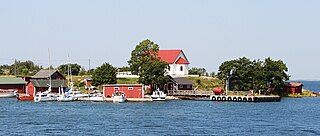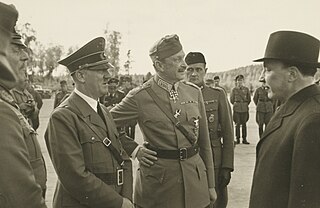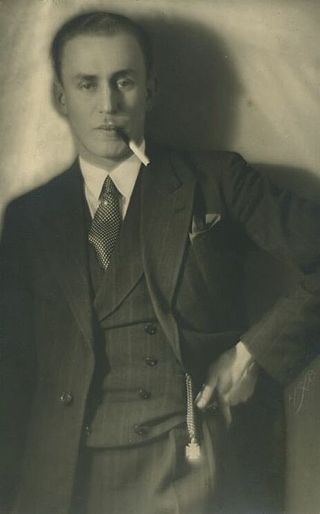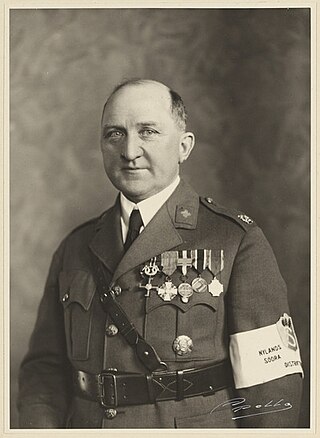Related Research Articles

The Continuation War, also known as the Second Soviet-Finnish War, was a conflict fought by Finland and Nazi Germany against the Soviet Union during World War II. It began with a Finnish declaration of war and invasion on 25 June 1941 and ended on 19 September 1944 with the Moscow Armistice. The Soviet Union and Finland had previously fought the Winter War from 1939 to 1940, which ended with the Soviet failure to conquer Finland and the Moscow Peace Treaty. Numerous reasons have been proposed for the Finnish decision to invade, with regaining territory lost during the Winter War regarded as the most common. Other justifications for the conflict include Finnish President Risto Ryti's vision of a Greater Finland and Commander-in-Chief Carl Gustaf Emil Mannerheim's desire to annex East Karelia.

Finland participated in the Second World War initially in a defensive war against the Soviet Union, followed by another, this time offensive, war against the Soviet Union acting in concert with Nazi Germany and then finally fighting alongside the Allies against Germany.
The Ryti–Ribbentrop letter of agreement was a personal letter from President of Finland Risto Ryti to German Führer Adolf Hitler signed on 26 June 1944. It was sent during the Soviet Vyborg–Petrozavodsk Offensive, which had started on 9 June and threatened to knock Finland out of the Continuation War.

Greater Finland, was an irredentist and nationalist idea that was a subset of Pan-Finnicism which emphasized the territorial expansion of Finland. The most common concept of Greater Finland saw the country as defined by natural borders encompassing the territories inhabited by Finns and Karelians, ranging from the White Sea to Lake Onega and along the Svir River and Neva River—or, more modestly, the Sestra River—to the Gulf of Finland. Some proponents also included the Torne Valley, Ingria, and Estonia.

The Axis leaders of World War II were important political and military figures during World War II. The Axis was established with the signing of the Tripartite Pact in 1940 and pursued a strongly militarist and nationalist ideology; with a policy of anti-communism. During the early phase of the war, puppet governments were established in their occupied nations. When the war ended, many of them faced trial for war crimes. The chief leaders were Adolf Hitler of Nazi Germany, Benito Mussolini of Fascist Italy, and Hirohito of Imperial Japan. Unlike what happened with the Allies, there was never a joint meeting of the main Axis heads of government, although Mussolini and Hitler met on a regular basis.
Kolmannen Valtakunnan vieraana is an essayistic book by Finnish writer Olavi Paavolainen based on his visit to Nazi Germany and the Nuremberg Rally in 1936.

During World War II, the Lapland War saw fighting between Finland and Nazi Germany – effectively from September to November 1944 – in Finland's northernmost region, Lapland. Though the Finns and the Germans had been fighting together against the Soviet Union since 1941 during the Continuation War (1941–1944), peace negotiations between the Finnish government and the Allies of World War II had been conducted intermittently during 1943–1944, but no agreement had been reached. The Moscow Armistice, signed on 19 September 1944, demanded that Finland break diplomatic ties with Germany and expel or disarm any German soldiers remaining in Finland.

Aspö is a small village on the Aspö Island in Pargas, Finland. Until 2009 it belonged to the municipality of Korpo. Its Finnish-language name is Haapasaari, although this name is seldom used. The village is known for its white limestone church that has a red brick roof. The current church was built in 1955–1956; however, a church has existed in the place since the Middle Ages. The old church was destroyed in a storm in 1949.

The Hitler and Mannerheim recording is a 1942 recording of a private conversation between German dictator Adolf Hitler, and Carl Gustaf Emil Mannerheim, Commander-in-Chief of the Finnish Defence Forces. It took place on a secret visit made to Finland by Hitler to honour Mannerheim's 75th birthday on 4 June 1942, during the Continuation War, a sub-theatre of World War II. Thor Damen, a sound engineer for the Finnish broadcaster Yleisradio (YLE) who had been assigned to record the official birthday proceedings, recorded the first eleven minutes of Hitler and Mannerheim's private conversation—without Hitler's knowledge. It is the only known recording of Hitler speaking in an unofficial tone.

The Night Frost Crisis or the Night Frost was a political crisis that occurred in Soviet–Finnish relations in the autumn of 1958. It arose from Soviet dissatisfaction with Finnish domestic policy and in particular with the composition of the third government to be formed under Prime Minister Karl-August Fagerholm. As a result of the crisis, the Soviet Union withdrew its ambassador from Helsinki and put pressure on the Finnish government to resign. The crisis was given its name by Nikita Khrushchev, who declared that relations between the countries had become subject to a "night frost".

Olavi Paavolainen was a Finnish writer, essayist and poet. He was one of the prominent figures of the literary group Tulenkantajat, and one of the most influential Finnish writers of the inter-war period. Paavolainen started his poetry career in the literary magazine Nuori Voima.

In Finland, the far right was strongest in 1920–1940 when the Academic Karelia Society, Lapua Movement, Patriotic People's Movement (IKL) and Vientirauha operated in the country and had hundreds of thousands of members. In addition to these dominant far-right and fascist organizations, smaller Nazi parties operated as well.
The Finnish Realm Union was an organization operating in Finland during the Continuation War, whose task was to bring together pro-Nazi forces under the same umbrella organization and at the same time bring them closer together. SVL's ultimate goal after the victory in the war was to form a one-party system in Finland like Germany.
The Finnish National Socialist Labor Organisation was a Finnish Nazi party led by Teo Snellman. The movement that operated during the armistice and the Continuation War was also known as the National Reform Labor Organization (KUT) and the Finnish National Socialist Workers' Party (SKTP). The party's organ was Vapaa Suomi, which appeared between 1940 and 1944.

Johan Christian Sergei Fabritius was a Finnish military lieutenant colonel.

Petter Teodor Forsström was a Finnish industrialist, Vuorineuvos and the father of the Lohja lime industry. Forsström worked as Lohjan Kalkkitehdas Oy's managing director for an exceptionally long period of time, 65 years. In 1946 he was sentenced to six years prison for treason after participating in the pro-German resistance movement in the late stages of the Continuation War and during the Lapland War.

Vietti Brynolf Nykänen was a Finnish architect, writer and politician.
Thoralf Kyrre was a Danish engineer who was involved in the pro-German resistance movement in Finland from 1944 to 1945.

Aarne Emil Kauhanen was a Finnish officer of the Central Detective Police (EK) and its successor, the State Police (ValPo), with special responsibility for aliens in the 1930s and 1940s. During the Continuation War, he acted as a liaison between the Finnish and Nazi German police authorities and was involved in the recruitment of the Finnish SS Battalion. Kauhanen also beat and tortured Jewish refugees during interrogations. After the war, he escaped to South America, where Kauhanen died in unclear circumstances in 1949. According to a memoir, one of his victims recognized and later shot him.

Carl-Gustaf Victor Herlitz was a Finnish business director and Vuorineuvos. He was the managing director of the Arabia porcelain factory in Helsinki from 1916 to 1947, when the Herlitz family was a major owner of Arabia. During his time, Arabia expanded its operations and became the largest company in the Nordic countries in its field. Herlitz was a member of the board of the Finnish Confederation of Employers in 1921–1929 and 1937–1947, and a representative of the Swedish People's Party in the Helsinki City Council from 1931 to 1934. Herlitz was radical right-wing in his political views and advocated a hard line in relation to the trade union movement.
References
- ↑ http://www.uta.fi/laitokset/historia/tutkijakoulu/sivut/paperi06/Petrus.Liukkonen.pdf [ dead link ]
- ↑ "Archived copy". Archived from the original on 2012-10-27. Retrieved 2006-12-14.
{{cite web}}: CS1 maint: archived copy as title (link)